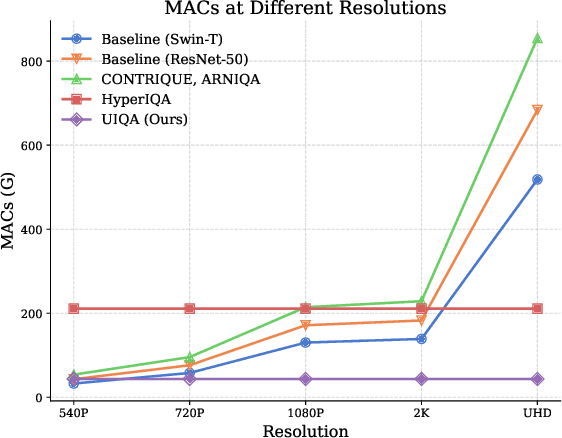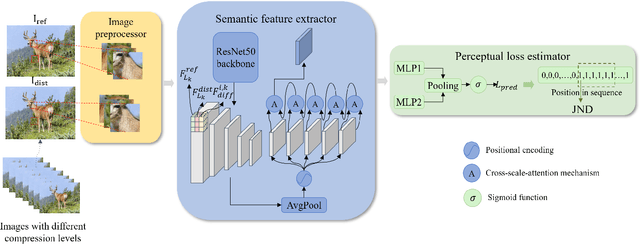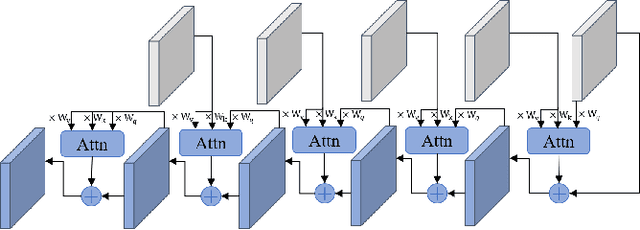Linhan Cao
Assessing UHD Image Quality from Aesthetics, Distortions, and Saliency
Sep 01, 2024



Abstract:UHD images, typically with resolutions equal to or higher than 4K, pose a significant challenge for efficient image quality assessment (IQA) algorithms, as adopting full-resolution images as inputs leads to overwhelming computational complexity and commonly used pre-processing methods like resizing or cropping may cause substantial loss of detail. To address this problem, we design a multi-branch deep neural network (DNN) to assess the quality of UHD images from three perspectives: global aesthetic characteristics, local technical distortions, and salient content perception. Specifically, aesthetic features are extracted from low-resolution images downsampled from the UHD ones, which lose high-frequency texture information but still preserve the global aesthetics characteristics. Technical distortions are measured using a fragment image composed of mini-patches cropped from UHD images based on the grid mini-patch sampling strategy. The salient content of UHD images is detected and cropped to extract quality-aware features from the salient regions. We adopt the Swin Transformer Tiny as the backbone networks to extract features from these three perspectives. The extracted features are concatenated and regressed into quality scores by a two-layer multi-layer perceptron (MLP) network. We employ the mean square error (MSE) loss to optimize prediction accuracy and the fidelity loss to optimize prediction monotonicity. Experimental results show that the proposed model achieves the best performance on the UHD-IQA dataset while maintaining the lowest computational complexity, demonstrating its effectiveness and efficiency. Moreover, the proposed model won first prize in ECCV AIM 2024 UHD-IQA Challenge. The code is available at https://github.com/sunwei925/UIQA.
SG-JND: Semantic-Guided Just Noticeable Distortion Predictor For Image Compression
Aug 08, 2024



Abstract:Just noticeable distortion (JND), representing the threshold of distortion in an image that is minimally perceptible to the human visual system (HVS), is crucial for image compression algorithms to achieve a trade-off between transmission bit rate and image quality. However, traditional JND prediction methods only rely on pixel-level or sub-band level features, lacking the ability to capture the impact of image content on JND. To bridge this gap, we propose a Semantic-Guided JND (SG-JND) network to leverage semantic information for JND prediction. In particular, SG-JND consists of three essential modules: the image preprocessing module extracts semantic-level patches from images, the feature extraction module extracts multi-layer features by utilizing the cross-scale attention layers, and the JND prediction module regresses the extracted features into the final JND value. Experimental results show that SG-JND achieves the state-of-the-art performance on two publicly available JND datasets, which demonstrates the effectiveness of SG-JND and highlight the significance of incorporating semantic information in JND assessment.
Enhancing Blind Video Quality Assessment with Rich Quality-aware Features
May 14, 2024Abstract:In this paper, we present a simple but effective method to enhance blind video quality assessment (BVQA) models for social media videos. Motivated by previous researches that leverage pre-trained features extracted from various computer vision models as the feature representation for BVQA, we further explore rich quality-aware features from pre-trained blind image quality assessment (BIQA) and BVQA models as auxiliary features to help the BVQA model to handle complex distortions and diverse content of social media videos. Specifically, we use SimpleVQA, a BVQA model that consists of a trainable Swin Transformer-B and a fixed SlowFast, as our base model. The Swin Transformer-B and SlowFast components are responsible for extracting spatial and motion features, respectively. Then, we extract three kinds of features from Q-Align, LIQE, and FAST-VQA to capture frame-level quality-aware features, frame-level quality-aware along with scene-specific features, and spatiotemporal quality-aware features, respectively. Through concatenating these features, we employ a multi-layer perceptron (MLP) network to regress them into quality scores. Experimental results demonstrate that the proposed model achieves the best performance on three public social media VQA datasets. Moreover, the proposed model won first place in the CVPR NTIRE 2024 Short-form UGC Video Quality Assessment Challenge. The code is available at \url{https://github.com/sunwei925/RQ-VQA.git}.
NTIRE 2024 Challenge on Short-form UGC Video Quality Assessment: Methods and Results
Apr 17, 2024



Abstract:This paper reviews the NTIRE 2024 Challenge on Shortform UGC Video Quality Assessment (S-UGC VQA), where various excellent solutions are submitted and evaluated on the collected dataset KVQ from popular short-form video platform, i.e., Kuaishou/Kwai Platform. The KVQ database is divided into three parts, including 2926 videos for training, 420 videos for validation, and 854 videos for testing. The purpose is to build new benchmarks and advance the development of S-UGC VQA. The competition had 200 participants and 13 teams submitted valid solutions for the final testing phase. The proposed solutions achieved state-of-the-art performances for S-UGC VQA. The project can be found at https://github.com/lixinustc/KVQChallenge-CVPR-NTIRE2024.
 Add to Chrome
Add to Chrome Add to Firefox
Add to Firefox Add to Edge
Add to Edge